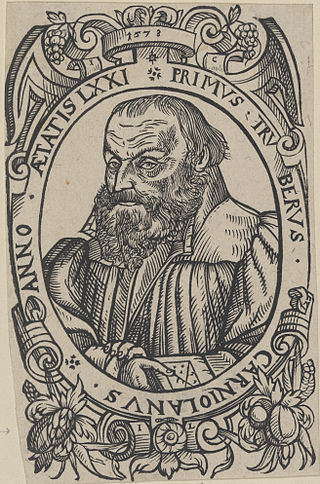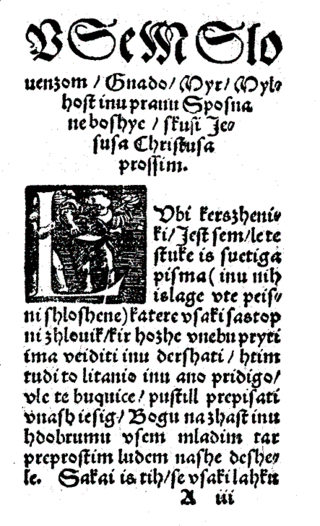Related Research Articles

Year 1550 (MDL) was a common year starting on Wednesday of the Julian calendar.

Year 1508 (MDVIII) was a leap year starting on Saturday of the Julian calendar.

Primož Trubar or Primus Truber was a Slovene Protestant Reformer of the Lutheran tradition, mostly known as the author of the first Slovene language printed book, the founder and the first superintendent of the Protestant Church of the Duchy of Carniola, and for consolidating the Slovenian language. Trubar introduced The Reformation in Slovenia, leading the Austrian Habsburgs to wage the Counter-Reformation, which a small Protestant community survived. Trubar is a key figure of Slovenian history and in many aspects a major historical personality.
This article presents lists of literary events and publications in the 16th century.
This article contains information about the literary events and publications of 1663.
This article contains information about the literary events and publications of 1650.
This article contains information about the literary events and publications of 1584.
This article contains information about the literary events and publications of 1561.
This article contains information about the literary events and publications of 1530.
This article contains information about the literary events and publications of 1508.
This article contains information about the literary events and publications of 1503.
Slovene literature is the literature written in Slovene. It spans across all literary genres with historically the Slovene historical fiction as the most widespread Slovene fiction genre. The Romantic 19th-century epic poetry written by the leading name of the Slovene literary canon, France Prešeren, inspired virtually all subsequent Slovene literature.

Pier Paolo Vergerio, the Younger, was an Italian papal nuncio and later Protestant reformer.

Catechismus in der windischenn Sprach or simply Catechismus, is a book written by the Slovene Protestant preacher Primož Trubar in 1550. Along with Trubar's 1550 book, Abecedarium (Abecedary), Catechismus was the first book published in Slovene. Catechismus served as part of a foundation of the establishment of a national identity for Slovenes.

Gian Giorgio Trissino, also called Giovan Giorgio Trissino and self-styled as Giovan Giωrgio Trissino, was a Venetian Renaissance humanist, poet, dramatist, diplomat, grammarian, linguist, and philosopher. He first proposed adding letters to the Italian alphabet to distinguish J from I, and V from U.

Abecedarium (Abecedary)—along with Catechismus (Catechism)—is the first printed book in Slovene. It is an eight-leaf booklet for helping people learn the alphabet. The protestant reformer Primož Trubar had it printed in 1550 in the schwabacher, and reprinted with some corrections in the Latin script in 1555 and 1566. An improved version of it was also printed by Sebastjan Krelj in 1566. Both Abecedarium and Catechismus are significant in the development of Slovene.

Bible translations into Serbian started to appear in fragments in the 11th century. Efforts to make a complete translation started in the 16th century. The first published complete translations were made in the 19th century.
Jovan Maleševac was a Serbian Orthodox monk and scribe who collaborated in 1561 with the Slovene Protestant reformer Primož Trubar to print religious books in Cyrillic. Between 1524 and 1546, Maleševac wrote five liturgical books in Church Slavonic at Serbian Orthodox monasteries in Herzegovina and Montenegro. He later settled in the region of White Carniola, in present-day Slovenia. In 1561, he was engaged by Trubar to proof-read Cyrillic Protestant liturgical books produced in the South Slavic Bible Institute in Urach, Germany, where he stayed for five months.

The South Slavic Bible Institute was established in Urach in January 1561 by Baron Hans von Ungnad, who was its owner and patron. Ungnad was supported by Christoph, Duke of Württemberg, who allowed Ungnad to use his castle of Amandenhof near Urach as a seat of this institute.
Events from the year 1550 in France
References
- ↑ E. van Staalduine-Sulman (13 November 2017). Justifying Christian Aramaism: Editions and Latin Translations of the Targums from the Complutensian to the London Polyglot Bible (1517-1657). BRILL. p. 98. ISBN 978-90-04-35593-4.
- ↑ Moody, T. W.; et al., eds. (1989). A New History of Ireland. 8: A Chronology of Irish History. Oxford University Press. ISBN 978-0-19-821744-2.
- ↑ Haase, Donald (2008). The Greenwood Encyclopedia of Folktales and Fairy Tales: A-F. Greenwood Publishing. p. 340. ISBN 0-313-33442-0.
- ↑ Robert Aldrich; Robert F. Aldrich; Garry Wotherspoon (2001). Who's who in Gay and Lesbian History: From Antiquity to World War II. Psychology Press. p. 58. ISBN 978-0-415-15982-1.
- ↑ Caroline Constant; Andrea Palladio (1993). The Palladio Guide. Princeton Architectural Press. p. 6. ISBN 978-1-878271-85-3.
- ↑ Holthöfer, Ernst (2001). "Eguinaire François, Baron de Kerlouan (Baro)". In Michael Stolleis (ed.). Juristen: ein biographisches Lexikon; von der Antike bis zum 20. Jahrhundert (in German) (2nd ed.). München: Beck. p. 64. ISBN 3-406-45957-9.